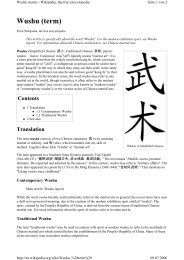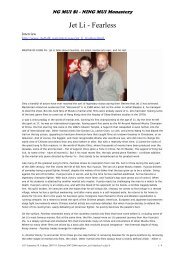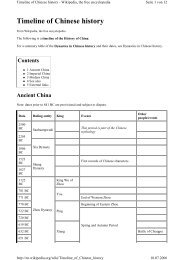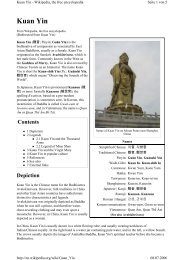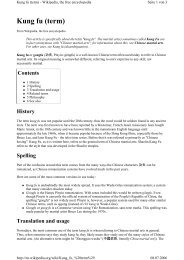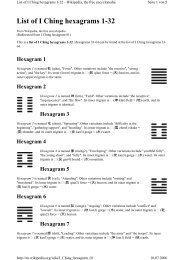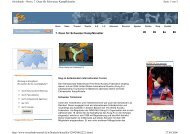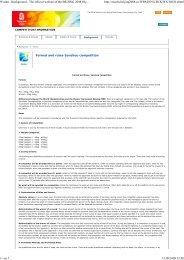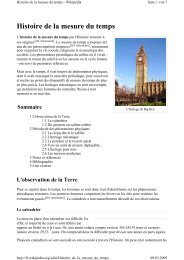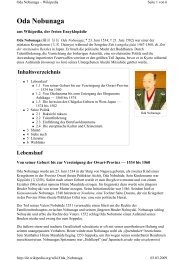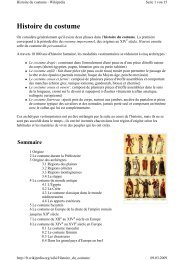Tien Shan Pai - Ning Mui Kung Fu Organisation
Tien Shan Pai - Ning Mui Kung Fu Organisation
Tien Shan Pai - Ning Mui Kung Fu Organisation
You also want an ePaper? Increase the reach of your titles
YUMPU automatically turns print PDFs into web optimized ePapers that Google loves.
<strong>Tien</strong> <strong>Shan</strong> <strong>Pai</strong> - Wikipedia, the free encyclopedia<br />
<strong>Tien</strong> <strong>Shan</strong> <strong>Pai</strong><br />
From Wikipedia, the free encyclopedia<br />
<strong>Tien</strong> <strong>Shan</strong> <strong>Pai</strong> (天山派) is a northern style of <strong>Kung</strong>-fu which originated in the <strong>Tien</strong> <strong>Shan</strong> mountains of<br />
northwestern China. It is well known in Taiwan as an effective fighting style. At the same time it also contains<br />
graceful empty-hand and weapons forms. It stresses rhythm, the demonstration of power accentuated by solid<br />
thuds made by the hands, the emitting of power from the entire body, the coordination of the hands and feet as<br />
well as blocks and strikes, high kicks and low sweeps, as well as locking and throwing techniques. <strong>Tien</strong> <strong>Shan</strong><br />
<strong>Pai</strong> self-defense is characterized by angular attacks coupled with multiple blocks. If one block fails, the<br />
second can cover. Footwork is considered essential to countering attacks. <strong>Tien</strong> <strong>Shan</strong> <strong>Pai</strong> focuses on low and<br />
steady steps to the side, along with swift "hidden" steps to trick the opponent. <strong>Pai</strong>red boxing forms and<br />
exercises are emphasized for timing and accurate evaluation of distance in reference to a moving, responsive<br />
adversary.<br />
Contents<br />
� 1 History<br />
� 2 Founding Legend<br />
� 3 Modern Practitioners<br />
� 4 Some Common Forms<br />
� 5 Sources<br />
� 6 External links<br />
History<br />
The following is a brief recent history of the <strong>Tien</strong> <strong>Shan</strong> <strong>Pai</strong> style:<br />
Seite 1 von 4<br />
63rd generation <strong>Tien</strong> <strong>Shan</strong> <strong>Pai</strong> Grandmaster Wang Chueh-Jen came from a rich family. His father, Wang Ting<br />
Yuen, was a well known <strong>Kung</strong> fu Master in Szechuan province. Grandmaster Wang first studied from his<br />
father before his father hired a different master to teach him and his brothers at home. Wang eventually<br />
inherited the <strong>Tien</strong> <strong>Shan</strong> <strong>Pai</strong> style from 62nd generation Grandmaster Ho Ta-Sun (also known as Ho Yuen-<br />
Ching).<br />
<strong>Tien</strong> <strong>Shan</strong> <strong>Pai</strong> has long been popular in Xinjiang, Gansu and other western provinces; however, it was not<br />
well known in eastern China and Taiwan until Wang Chueh-Jen taught there. Through many years of study<br />
and teaching, Grandmaster Wang refined a style of combat he called "radar style fighting". Many of his early<br />
students competed in lei tai (full contact fighting) tournaments, all giving outstanding performances, with<br />
some winning championships. At that time (1955), there were no weight divisions (until 1957, when three<br />
weight divisions were established) and no protection. The last such tournament without protection was held in<br />
Taiwan, Republic of China in 1986.<br />
Grandmaster Willy Lin was born in 1938 in Tai-Chung, Taiwan. Lin became a student of Wang Chueh-Jen in<br />
<strong>Tien</strong> <strong>Shan</strong> <strong>Pai</strong> in 1957 in his hometown of Taichung, Taiwan. For eight years, from 1960 until he emigrated to<br />
the United States by way of Brazil, Willy Lin was the head instructor and primary assistant to Wang Chueh-<br />
Jen.<br />
In 1968 Willy Lin emigrated from Taiwan to Sao Paulo, Brazil, where he taught martial arts to the Sao Paulo<br />
Chinese Association and to the Sao Paulo Police Department. In 1970 he came to the United States, where he<br />
opened his first school in 1971 in the Washington DC area.<br />
Willy Lin was the first person to introduce and to teach Wang Chueh-Jen's system of <strong>Tien</strong> <strong>Shan</strong> <strong>Pai</strong> in the<br />
United States. Willy Lin currently resides in New York. He still teaches, and does seminars on <strong>Tien</strong> <strong>Shan</strong> <strong>Pai</strong>,<br />
http://en.wikipedia.org/wiki/<strong>Tien</strong>_<strong>Shan</strong>_<strong>Pai</strong><br />
10.07.2006
<strong>Tien</strong> <strong>Shan</strong> <strong>Pai</strong> - Wikipedia, the free encyclopedia<br />
and on the forms which comprise it.<br />
He brought Grandmaster Huang Chien-Liang to the United States in 1973 to become one of Lin's instructors<br />
at the Lin <strong>Kung</strong> <strong>Fu</strong> School in Bethesda, MD. He also brought Grandmaster Tony Lin, and Grandmaster C.C.<br />
Liu to the United States in the early 1970s to become instructors at the Lin <strong>Kung</strong> <strong>Fu</strong> Schools.<br />
Huang claims that Wang Chueh-Jen informed Grandmaster Huang Chien-Liang that Huang was his only<br />
"formal disciple" during a visit to the U.S. in 1985 at which time Huang assumed the title of 64th Generation<br />
Grandmaster of <strong>Tien</strong> <strong>Shan</strong> <strong>Pai</strong>. Huang Chien-Liang is currently the President of The World Kuoshu<br />
Federation (TWKSF), Vice President of the International Chinese Kuoshu Federation (ICKF), and President<br />
of the United States Chinese Kuoshu Federation (USCKF).<br />
Wang Chueh-Jen continued to teach <strong>Tien</strong> <strong>Shan</strong> <strong>Pai</strong> until his death in 1990.<br />
Willy Lin, Huang Chien-Liang, C.C. Liu, and Tony Lin are a few of Wang's original students who are still<br />
active practitioners and teachers of <strong>Tien</strong> <strong>Shan</strong> <strong>Pai</strong> in the United States today.<br />
Founding Legend<br />
<strong>Tien</strong> <strong>Shan</strong> <strong>Pai</strong> <strong>Kung</strong> fu originated in Xinjiang Province in Northwestern China. Legend has it that it was<br />
practiced by monks who lived in a temple nestled among the snow-capped peaks of the <strong>Tien</strong> <strong>Shan</strong> mountains.<br />
As the story goes, a young herdsman who was searching for lost animals wandered too far from home. The<br />
grasslands he knew so well suddenly looked unfamiliar and he realized he was lost. Noticing an old monk<br />
with long white beard approaching nearby, the boy stopped him and asked for directions. When he returned to<br />
his village, the boy told his mother about the old monk. She replied he had met <strong>Tien</strong> <strong>Shan</strong> Lao Ren, a monk<br />
who was noted for his martial arts skills. The mother encouraged her son to find the monk and learn his <strong>Kung</strong><br />
fu secret.<br />
The young boy set out to find the old monk. His quest carried him deep into the mountains. He searched for<br />
mile after mile, but could not find the old monk. At the point of physical exhaustion, the young boy stopped at<br />
nearby stream to quench his thirst. While kneeling by the stream, he saw the reflection of a beautiful temple<br />
nestled in a snow-capped mountain. Sensing he was close, the young boy hastened onwards.<br />
After a long trek into the mountains, the boy finally arrived at the temple. However, his hopes were dashed<br />
when the monk refused to accept him as a disciple. They were not permitted to teach outsiders, the monk<br />
explained. But instead of going home as they suggested, the boy knelt in the snow outside the temple doors,<br />
refusing to leave until the old monk would agree to teach him. On the second morning, he was discovered<br />
lying unconscious from the cold and was taken into the temple.<br />
Seeing his determination, the old monk reconsidered. <strong>Tien</strong> <strong>Shan</strong> Lao Ren decided to teach the boy, whom he<br />
nicknamed Hong Yun (Red Cloud) because of the mist that rose from his bleeding knees when he was<br />
discovered outside of the temple. He stayed in the temple until he grew to manhood, and when he left, he<br />
eagerly passed on his skill to other dedicated students. Hong Yun Zu Shi, as the first to teach the monks<br />
martial artistry to the outside world, is regarded as the founder of <strong>Tien</strong> <strong>Shan</strong> <strong>Pai</strong>.<br />
Modern Practitioners<br />
Seite 2 von 4<br />
<strong>Tien</strong> <strong>Shan</strong> <strong>Pai</strong> is an active style of <strong>Kung</strong> fu practiced by many in the United States and around the world.<br />
Grandmaster Huang Chien-Liang resides and still teaches at the primary school in Maryland. Most<br />
practitioners learn aspects of northern Shaolin <strong>Kung</strong> fu and Yang style Tai Chi Chuan as well as traditional<br />
<strong>Tien</strong> <strong>Shan</strong> <strong>Pai</strong>.<br />
http://en.wikipedia.org/wiki/<strong>Tien</strong>_<strong>Shan</strong>_<strong>Pai</strong><br />
10.07.2006
<strong>Tien</strong> <strong>Shan</strong> <strong>Pai</strong> - Wikipedia, the free encyclopedia<br />
Some Common Forms<br />
Kuo Shu Forms<br />
Chu Chi Chuan ‘Primary Fist’<br />
LianBu Chuan ‘Linking Steps Boxing’ (aka 龙拳 Lung Chuan ‘Dragon Fist’)<br />
Chung Chi Chuan ‘Intermediate Fist’<br />
Gung Li Chuan ‘Power Development Fist’<br />
Man Jiang Hong ‘Whole River Red’<br />
Mi Tsung ‘Lost Track’ Forms<br />
Ji Chuan ‘Sudden Attack’<br />
Pa Chi Quan ‘Eight Extremes Fist’<br />
Lo Han Chuan "Lo Han Boxing"<br />
Cha Chuan Jiao Men ‘Cha Fist Sect Boxing’ Forms<br />
Tan Tui ‘Spring Leg’<br />
Yuan Yang Chuan ‘Mandarin Duck Boxing’ Forms<br />
Yuan Yang Tui ‘Mandarin Duck Kicks’<br />
Sun Ping Chuan ‘Sun Ping Boxing’ Forms<br />
San Shi Er Sun Bin ‘Thirty Two Sun Bin’<br />
Liang <strong>Shan</strong> Chuan ‘Liang Mountain Boxing’<br />
Shi Er Tui ‘Twelve Kicks’<br />
Lian Huan Tui ‘Continuous Linking Kicks’<br />
Mei Hua Chuan ‘Plum Flower Fist’<br />
Shao Hong Chuan ‘Little Red Boxer’<br />
Sources<br />
<strong>Tien</strong> <strong>Shan</strong> <strong>Pai</strong> Association. 13 Dec. 2005 .<br />
Lin <strong>Kung</strong> <strong>Fu</strong>. 2005. .<br />
External links<br />
� The <strong>Tien</strong> <strong>Shan</strong> <strong>Pai</strong> association (http://www.tienshanpai.org/tienshanpai/index.shtml)<br />
� <strong>Tien</strong> <strong>Shan</strong> <strong>Pai</strong> association official list of schools<br />
(http://www.tienshanpai.org/tienshanpai/schools/index.shtml)<br />
http://en.wikipedia.org/wiki/<strong>Tien</strong>_<strong>Shan</strong>_<strong>Pai</strong><br />
Seite 3 von 4<br />
10.07.2006
<strong>Tien</strong> <strong>Shan</strong> <strong>Pai</strong> - Wikipedia, the free encyclopedia<br />
� Grandmaster Willy Lin who introduced <strong>Tien</strong> <strong>Shan</strong> <strong>Pai</strong> to the US (http://www.linkungfu.com/)<br />
� <strong>Tien</strong> <strong>Shan</strong> <strong>Pai</strong> lineage and schools (http://www.linkungfu.com/tsplinks.html)<br />
Retrieved from "http://en.wikipedia.org/wiki/<strong>Tien</strong>_<strong>Shan</strong>_<strong>Pai</strong>"<br />
Category: Chinese martial arts<br />
http://en.wikipedia.org/wiki/<strong>Tien</strong>_<strong>Shan</strong>_<strong>Pai</strong><br />
Seite 4 von 4<br />
� This page was last modified 03:56, 26 May 2006.<br />
� All text is available under the terms of the GNU Free<br />
Documentation License. (See Copyrights for details.)<br />
Wikipedia® is a registered trademark of the Wikimedia<br />
Foundation, Inc.<br />
10.07.2006



